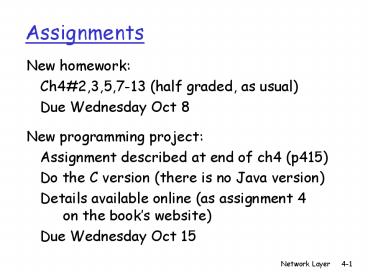Assignments - PowerPoint PPT Presentation
1 / 22
Title:
Assignments
Description:
Details available online (as assignment 4 on the book's website) Due Wednesday Oct 15 ... no 'flag days' How will the network operate with mixed IPv4 and IPv6 routers? ... – PowerPoint PPT presentation
Number of Views:47
Avg rating:3.0/5.0
Title: Assignments
1
Assignments
- New homework
- Ch42,3,5,7-13 (half graded, as usual)
- Due Wednesday Oct 8
- New programming project
- Assignment described at end of ch4 (p415)
- Do the C version (there is no Java version)
- Details available online (as assignment 4 on
the books website) - Due Wednesday Oct 15
2
Chapter 4 roadmap
- 4.1 Introduction and Network Service Models
- 4.2 Routing Principles
- 4.3 Hierarchical Routing
- 4.4 The Internet (IP) Protocol
- 4.5 Routing in the Internet
- 4.6 Whats Inside a Router?
- 4.7 IPv6
- 4.8 Multicast Routing
- 4.9 Mobility
3
Router Architecture Overview
- Two key router functions
- run routing algorithms/protocol (RIP, OSPF, BGP)
- switching datagrams from incoming to outgoing link
4
Input Port Functions
Physical layer bit-level reception
- Decentralized switching
- given datagram dest., lookup output port using
routing table in input port memory - goal complete input port processing at line
speed - queuing if datagrams arrive faster than
forwarding rate into switch fabric
Data link layer e.g., Ethernet see chapter 5
5
Input Port Queuing
- Fabric slower that input ports combined -gt
queueing may occur at input queues - Head-of-the-Line (HOL) blocking queued datagram
at front of queue prevents others in queue from
moving forward - queueing delay and loss due to input buffer
overflow!
6
Three types of switching fabrics
7
Switching Via Memory
- First generation routers
- packet copied by systems (single) CPU
- speed limited by memory bandwidth (2 bus
crossings per datagram)
- Modern routers
- input port processor performs lookup, copy into
memory - Cisco Catalyst 8500
8
Switching Via a Bus
- datagram from input port memory
- to output port memory via a shared bus
- bus contention switching speed limited by bus
bandwidth - 1 Gbps bus, Cisco 1900 sufficient speed for
access and enterprise routers (not regional or
backbone)
9
Switching Via An Interconnection Network
- Designed to overcome bus bandwidth limitations
- Banyan networks, other interconnection nets
initially developed to connect processors in
multiprocessor - Advanced design fragmenting datagram into fixed
length cells, switch cells through the fabric. - Cisco 12000 switches Gbps through the
interconnection network
10
Output Ports
- Buffering required when datagrams arrive from
fabric faster than the transmission rate - Scheduling discipline chooses among queued
datagrams for transmission
11
Output port queueing
- buffering when arrival rate via switch exceeds
output line speed - queueing (delay) and loss due to output port
buffer overflow!
12
Chapter 4 roadmap
- 4.1 Introduction and Network Service Models
- 4.2 Routing Principles
- 4.3 Hierarchical Routing
- 4.4 The Internet (IP) Protocol
- 4.5 Routing in the Internet
- 4.6 Whats Inside a Router?
- 4.7 IPv6
- 4.8 Multicast Routing
- 4.9 Mobility
13
IPv6
- Initial motivation 32-bit address space
completely allocated by 2008. - Additional motivation
- header format helps speed processing/forwarding
- header changes to facilitate QoS
- new anycast address route to best of several
replicated servers - Implemented in many Internet-capable cell phones,
and internally in some countries - IPv6 datagram format
- fixed-length 40 byte header
- no fragmentation allowed
14
IPv6 Header (Cont)
Priority identify priority among datagrams in
flow Flow Label identify datagrams in same
flow. (concept offlow
not well defined). Next header identify upper
layer protocol for data
15
Other Changes from IPv4
- Checksum removed entirely to reduce processing
time at each hop - Options allowed, but outside of header,
indicated by Next Header field - ICMPv6 new version of ICMP
- additional message types, e.g. Packet Too Big
- multicast group management functions
16
Transition From IPv4 To IPv6
- Not all routers can be upgraded simultaneously
- no flag days
- How will the network operate with mixed IPv4 and
IPv6 routers? - Two proposed approaches
- Dual Stack some routers with dual stack (v6, v4)
can translate between formats - Tunneling IPv6 carried as payload in IPv4
datagram among IPv4 routers
17
Dual Stack Approach
IPv6
IPv6
IPv6
IPv6
IPv4
IPv4
A-to-B IPv6
B-to-C IPv4
B-to-C IPv6
B-to-C IPv4
18
Tunneling
tunnel
Logical view
IPv6
IPv6
IPv6
IPv6
Physical view
IPv6
IPv6
IPv6
IPv6
IPv4
IPv4
A-to-B IPv6
E-to-F IPv6
B-to-C IPv6 inside IPv4
B-to-C IPv6 inside IPv4
19
Chapter 4 roadmap
- 4.1 Introduction and Network Service Models
- 4.2 Routing Principles
- 4.3 Hierarchical Routing
- 4.4 The Internet (IP) Protocol
- 4.5 Routing in the Internet
- 4.6 Whats Inside a Router?
- 4.7 IPv6
- 4.8 Multicast Routing
- 4.9 Mobility
20
Multicast one sender to many receivers
- Multicast act of sending datagram to multiple
receivers with single transmit operation - analogy one teacher to many students
- Question how to achieve multicast
21
Multicast one sender to many receivers
- Multicast act of sending datagram to multiple
receivers with single transmit operation - analogy one teacher to many students
- Question how to achieve multicast
- Network multicast
- Router actively participate in multicast, making
copies of packets as needed and forwarding
towards multicast receivers
Multicast routers (red) duplicate and forward
multicast datagrams
22
Multicast one sender to many receivers
- Multicast act of sending datagram to multiple
receivers with single transmit operation - analogy one teacher to many students
- Question how to achieve multicast
- Application-layer multicast
- end systems involved in multicast copy and
forward unicast datagrams among themselves































